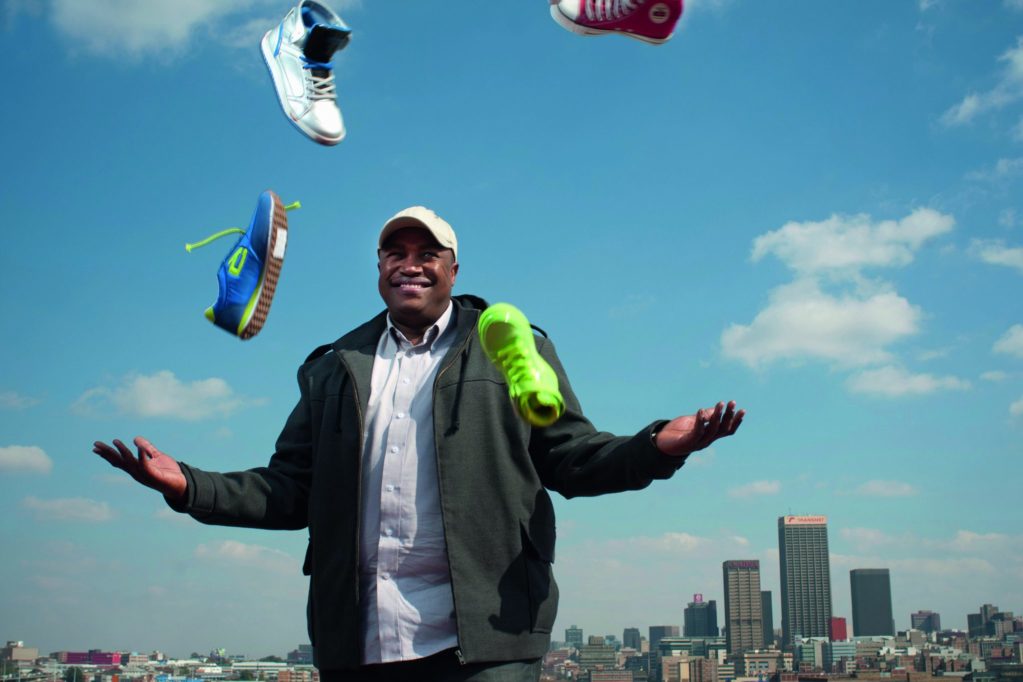When businessman Wandi Nzimande was a Wandi Nzimande student in Johannesburg back in the early 1990s, he and his boyhood best friend, Sechaba ‘Chabi’ Mogale, had to help out at Nzimande’s parents’ second-hand clothing store to earn extra pocket money. The job was pretty uncool, and in a bid to find ways of making this unfashionable chore bearable, they got into the habit of changing and redesigning some of the old rags to better suit their personal style. When more and more fellow varsity students started buying the reworked wares off the two friends’ backs, the duo discovered that they were onto something big.
It was 13 years ago that the brand, Loxion Kulca, was born, and through incredibly trying times—due to the competitive nature of the fashion and leisure industry, the counterfeit trade and their own internal wrangling—Loxion Kulca lives and is sold by over
1,000 retailers across Africa.
“Getting into fashion had actually never crossed my mind,” says Nzimande. “I was at university studying mathematics and preparing for an academic career,” he explains.
It was only when he started spending more time with Mogale that he started developing an interest in black ghetto culture and how fashionably edgy it was. “Chabi had lived most of his childhood in the States as part of a family who had been in exile. Upon his return, he brought with him a wealth of magazines, videos and vivid stories and images of how the culture was where he came from. As a young boy who had never been outside South Africa, I was hugely fascinated, and I shared with him my own ghetto stories from having lived in Soweto all my life,” he says.
Loading...
After their peers started buying more and more of their brand, they decided they were going to turn this into a business, after all. “We started coming up with fresh designs, as opposed to amending the second-hand stuff from my parents’ store. We took the money we were making and started producing beanies and light-knit jerseys, and those sold as quickly as we could make them. We hired seamstresses and sooner than we knew it, we started becoming inundated with orders as word of mouth about our brand spread like wildfire,” Nzimande remembers.
In 1997, their partnership with popular youth radio station YFM catapulted their popularity to dizzy heights. Hot kwaito artists and anybody who was considered to have any kind of street-cred was sporting their label. “At that point, getting celebrities to endorse our brand was important to us. We were on red carpets, we were in newspapers and on television, but we were clearly missing someone with a long-term strategy who would help us move from being just a fad into a fully fledged fashion empire,” recalls Nzimande.
The duo approached the late Brian Abrahams, the man who was then one of Johannesburg’s most experienced clothing franchisers. Abrahams had been responsible for licensing brands such as Wrangler Jeans and Caterpillar to South Africa in the 1970s. “Abrahams had his doubts about our brand and if it would have longevity, but he put his doubts aside and taught us everything we needed to know about the corporate side of running a fashion business. Chabi and I were the creatives; Abrahams became the third partner and came with an incredible network of contacts,” says Nzimande.
With Abrahams’ vision and support, Loxion Kulca became a national retail operation. They grew their range and from just beanies, T-shirts and jerseys, they ventured into shoes and eyewear. Then in 1999, former fashion house Sales House commissioned them to supply 150 of their chain stores. By 2003, their annual turnover was reported to be around the R80 million mark ($10 million at the time). Then trouble set in. “Abrahams died unexpectedly after being involved in a motorcycle accident and that deeply traumatized us. A legal battle between us and his family over his share of the business ensued, and then Chabi and I began having serious differences regarding how we wanted to move forward with the business,” says Nzimande.
Mogale decided to resign from the business, adding more uncertainty to the future of the fashion label. “The Abrahams family and I reached an understanding out of court, and it was agreed that Abrahams’ son, Gideon, was to take over where his father left off,” says Nzimande. But it would be an uphill battle to restore the label to its former glory. Newer, fresher labels had come up, and the business was not making anything near what it used to generate in its heyday. “We had serious trouble with counterfeiters. Many of our retailers backed out of our contracts because at any point, there would be five or six hawkers outside their shop doors selling fake Loxion Kulca items for a song,” says Nzimande.
Realizing that winning the war against the counterfeit trade was not likely to happen, Nzimande and the younger Abrahams decided on a revamped business model for the brand. “We are now fully a licensing business. We have a global copyright to our brand, so what we basically do is license our brand out, and the ‘licensee’ becomes responsible for the research and development, the design, manufacture and distribution. Once they collect the money made from the merchandise, they then pay us our royalties. We decided on this model as a way of making sure that the brand does not die and that it gets consistently revitalized and energized.
“Right now, our brand is carried in over 1,000 eye-wear stores across the continent and in over 500 clothing and shoe retailers. As Loxion Kulca, we also help develop new fashion enterprises and partner with up-and-coming fashion designers. We have decided to step away from any campaign driven by popular culture as we feel the brand has stood the test of time. That is proving to work as 2011 was our biggest financial year to date,” concludes Nzimande.
Loading...
